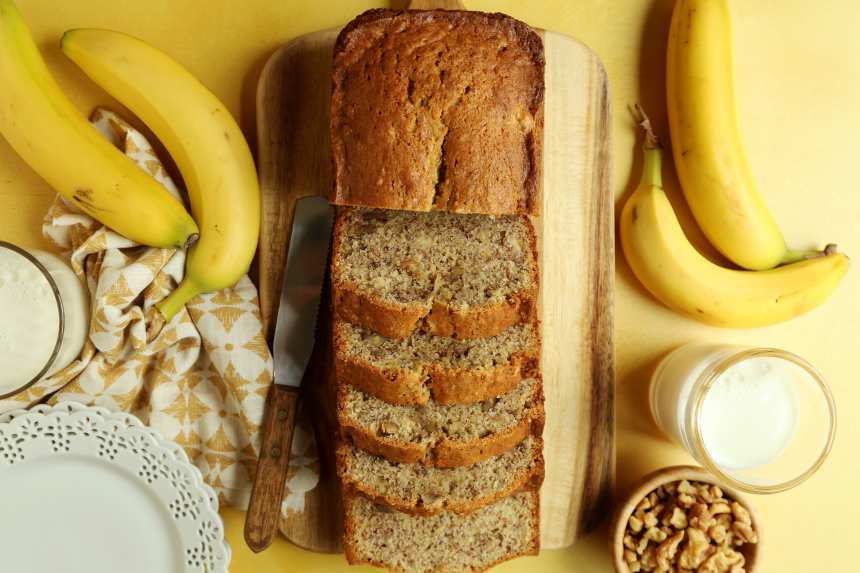Embracing the Aroma: The Allure of Banana Bread
Banana bread holds a special place in the hearts of many, with its comforting aroma and moist, flavorful crumb. This beloved baked good is not only a delicious way to use up ripe bananas but also a versatile treat that can be enjoyed any time of day. From breakfast to dessert, banana bread never fails to satisfy cravings and evoke feelings of warmth and nostalgia.

1. The Origins of Banana Bread
The origins of banana bread can be traced back to the Great Depression era in the United States when resourceful home cooks sought ways to make the most of limited ingredients. Ripe bananas, often discarded due to their overripe state, were transformed into a moist and flavorful quick bread that became a staple in American households. Over time, banana bread gained popularity worldwide, with variations and adaptations reflecting regional tastes and preferences.
2. Key Ingredients and Techniques
The success of a banana bread recipe hinges on a few key ingredients and techniques. Ripe bananas are the star of the show, providing natural sweetness and moisture to the bread. The addition of eggs, sugar, flour, and leavening agents such as baking powder and baking soda creates a tender crumb and ensures proper rise. A touch of vanilla extract and spices like cinnamon or nutmeg adds depth of flavor, while optional mix-ins like nuts or chocolate chips provide texture and indulgence.
Crafting the Perfect Banana Bread: A Step-by-Step Guide
Creating the perfect banana bread is a simple yet rewarding endeavor that anyone can master with a little patience and attention to detail. Follow these steps to bake a loaf that’s moist, flavorful, and utterly irresistible:
1. Preparation
Start by preheating your oven to the specified temperature and preparing your loaf pan by greasing it or lining it with parchment paper. This ensures that your banana bread will release easily from the pan once it’s baked.
2. Mashing the Bananas
In a large mixing bowl, mash the ripe bananas with a fork or potato masher until smooth and no large lumps remain. This step is essential for incorporating the bananas evenly throughout the batter and ensuring a moist and flavorful finished product.
3. Mixing the Wet Ingredients
Add the eggs, sugar, melted butter or oil, and vanilla extract to the mashed bananas, and whisk until well combined. This creates a wet mixture that will serve as the base for your banana bread batter.
4. Combining the Dry Ingredients
In a separate bowl, whisk together the flour, baking powder, baking soda, salt, and any spices or flavorings called for in the recipe. This ensures that the dry ingredients are evenly distributed and prevents clumps from forming in the batter.
5. Folding in the Dry Ingredients
Gradually add the dry ingredients to the wet ingredients, stirring gently with a spatula or wooden spoon until just combined. Be careful not to overmix, as this can result in a tough or dense banana bread.
6. Adding Mix-Ins (Optional)
If desired, fold in any mix-ins such as chopped nuts, chocolate chips, or dried fruit at this stage. These additions add texture and flavor to the banana bread and can be customized to suit your preferences.
7. Baking
Pour the batter into the prepared loaf pan and smooth the top with a spatula. Bake in the preheated oven until golden brown and a toothpick inserted into the center comes out clean, indicating that the bread is fully cooked.
8. Cooling and Serving
Allow the banana bread to cool in the pan for a few minutes before transferring it to a wire rack to cool completely. Once cooled, slice the banana bread and serve it plain or with a pat of butter for added richness.
Creative Variations: Putting a Unique Spin on Banana Bread
While classic banana bread is delicious on its own, there are countless ways to customize this versatile treat to suit your taste preferences and dietary restrictions. Here are a few creative variations to consider:
1. Whole Grain Banana Bread
Swap out some or all of the all-purpose flour in your banana bread recipe with whole grain flour such as whole wheat or spelt flour for added fiber and nutrients. You can also experiment with alternative flours like almond flour or coconut flour for a gluten-free option.
2. Vegan Banana Bread
Make your banana bread vegan-friendly by replacing the eggs with a flax egg or mashed ripe avocado and using plant-based milk and vegan butter or oil. This creates a moist and flavorful banana bread that’s suitable for those following a vegan lifestyle.
3. Nutty Banana Bread
Add chopped nuts such as walnuts, pecans, or almonds to your banana bread batter for a crunchy texture and nutty flavor. Toasting the nuts beforehand enhances their flavor and adds depth to the banana bread.
Conclusion: Savoring the Simple Pleasures of Banana Bread
In conclusion, banana bread is a timeless classic that never fails to delight with its comforting flavor and moist, tender crumb. Whether enjoyed warm from the oven with a smear of butter or sliced and toasted for breakfast, banana bread is a versatile treat that brings joy to any occasion. With a few simple ingredients and a little bit of know-how, you can bake a loaf of banana bread that’s sure to impress family and friends and become a cherished favorite for years to come. So embrace the allure of banana bread and savor the simple pleasures of homemade baking at its finest.